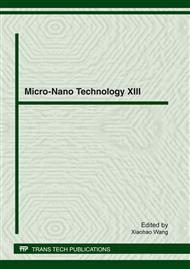p.3
p.8
p.12
p.18
p.24
p.29
p.35
p.43
A High-Order Curvature-Compensated Bandgap Voltage Reference for Micro-Gyroscope
Abstract:
The reference is an important part of the micro-gyroscope system. The precision and stability of the reference directly affect the precision of the micro-gyroscope. Unlike the traditional bandgap reference circuit, a circuit using a temperature-dependent resistor ratio generated by a highly-resistive poly resistor and a diffusion resistor in CMOS technology is proposed in this paper. The complexity of the circuit is greatly reduced. Implemented with the standard 0.5μm CMOS technology and 9V power supply voltage, in the range of -40~120°C, the temperature coefficient of the proposed bandgap voltage reference can achieve to about 1.6 ppm/°C. The PSRR of the circuit is -107dB.
Info:
Periodical:
Pages:
12-17
Citation:
Online since:
February 2012
Authors:
Price:
Сopyright:
© 2012 Trans Tech Publications Ltd. All Rights Reserved
Share:
Citation:


